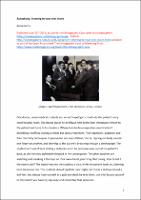Chapter 3 Autophony: Listening to your Eyes Move
Author(s)
Harris, Anna
Contributor(s)
Yates-Doerr, Emily (editor)
Labuski, Christine (editor)
Collection
European Research Council (ERC); ScholarLed; Dutch Research Council (NWO); EU collectionLanguage
EnglishAbstract
I observed many instances of self-percussion during my fieldwork researching how listening
to sounds is learned, taught and practiced in a Melbourne medical school and it’s connected
teaching hospital. The students were sounding out their own bodies; practicing the
technique while also feeling “dull” or “resonant” on their own body. This knowledge was
then to be applied during their examination of patients, where dullness or resonance in the
“wrong” place or in uneven distribution, may indicate disease. Tom Rice (2013) also
observed similar acts of self-listening in a London hospital, in the form of auto-auscultation.
The first sounds a medical student listens to, Rice found, when they buy their first
stethoscope, are often their own. What does it mean to use your body as a case for others?
Medical students (and indeed many other practitioners of the body) do this all the time. It is
a common way of learning new bodily skills and bodily knowledge.
Keywords
AutophonyDOI
10.28938/995527744OCN
1147274524Publisher
Mattering PressPublisher website
https://www.matteringpress.org/Publication date and place
Manchester, 2017Grantor
Classification
Society and culture: general


 Download
Download